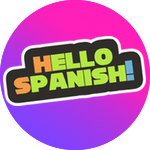Understanding The Basis
First, recognize that studying isn't a one-size-fits-all approach every time you "think" you're studying.
The key to success? Embrace "Active Immersion." There are countless ways to dive in—whether it's binge-watching a Spanish Netflix show, exploring the magical world of Harry Potter in Spanish, grooving to your favorite Shakira tune (#TeamShakira), or tuning in to a beginner-friendly HelloSpanish Podcast.
Let's use the Harry Potter book as an example. It's always best to start with easy content (like these comprehensible input videos), but if you're a Potterhead, there are two ways to immerse yourself: Total Immersion and Partial Immersion.
Total Immersion
This method is better explained as reading every page next to a dictionary and looking up every word you encounter and also making flashcards every time you finish a reading session. Sure, you are going to get a huge amount of vocabulary and build your knowledge faster, but –yes, here comes the but–, how long do you honestly think you can sustain such a level of focus and diligence. If you answered a lot, then skip to stage 4, but if you are like the vast majority of people that do not have that much time or ability to focus for long periods of time, then this is not probably your primary approach. Using Total Immersion is a great way to take longer steps into your journey, but not the most adequate early on.
Partial Immersion: What Most people opt for
Grab your Harry Potter book and read without stopping, highlighting unknown words. You'll understand less but enjoy more, keeping motivation high as you progress with the story. The downside? Less pressure means fewer gains. You might look up highlighted words later, but let's be honest, going back to reread and do some hard work isn't always appealing.
So, what if there's a balance?
Two-Way Immersion - The Perfect Blend.
This time, pick up your Harry Potter book and begin reading. Instead of stopping at each challenging word, highlight them as you go. When you come across an unfamiliar word repeatedly, it's an indication that you may need to learn it to keep comprehension levels high. It's not necessary to know every word before reading the story once or twice, but certain words in a narrative are more significant as they offer a more comprehensive grasp of the storyline. Make brief stops to look up words and take extended breaks to make Anki flashcards when needed. Finding the right balance between both methods will lead you to your unique learning groove.
Now, let's talk about listening.
Input Approach divides listening into Active and Passive Listening.
Passive Listening involves playing your favorite song or podcast while driving. Sure, you're exposed to Spanish, but your focus is elsewhere. Is there any benefit? Absolutely! Your brain is subconsciously processing new sounds and trying to form words and sentences, but it needs your help.
Active Listening is your ultimate goal. Sing along to a song, mimic podcast speakers, or just sit and listen attentively. Find content that engages you, like Peppa Pig en Español or Los Simpsons. Aim for Active Listening when possible, but if your only chance to listen is while driving, Passive Listening is still better than nothing.




